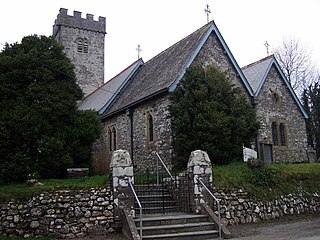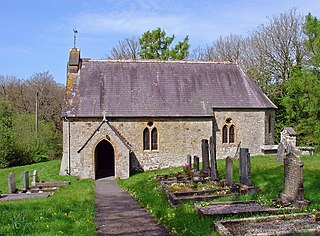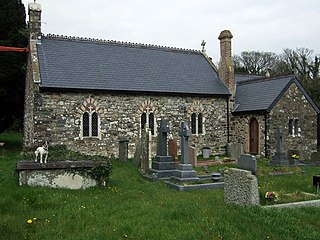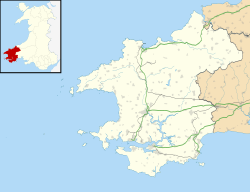
Friends of Friendless Churches is a registered charity formed in 1957, active in England and Wales, which campaigns for and rescues redundant historic places of worship threatened by demolition, decay, or inappropriate conversion. As of April 2021, the charity owns 58 redundant churches or chapels, 29 of which are in England, and 29 in Wales.

Monkton is a village and parish adjoining Pembroke, Pembrokeshire, Wales. According to the United Kingdom Census 2001, the population was 1,688.
Castlemartin is a village and parish in the community of Stackpole and Castlemartin, Pembrokeshire, Wales, in the Pembrokeshire Coast National Park.

St Beuno's Church, Penmorfa, is a redundant church near the settlement of Penmorfa, some 2 miles (3 km) to the northwest of Porthmadog, Gwynedd, Wales. It is designated by Cadw as a Grade II* listed building, and is under the care of the Friends of Friendless Churches.

Warren is an ancient parish in the community of Stackpole and Castlemartin, in the most southerly part of Pembrokeshire, Wales. Its northern edge is 5 miles (8 km) south of Pembroke and its southern edge reaches the sea at Flimston Bay. It is bordered by Castlemartin to the west, St Twynnells to the east and Monkton to the north.

St Michael and All Angels Church, Llanfihangel Rogiet, is a redundant church in the hamlet of Llanfihangel Rogiet near the village of Rogiet, Monmouthshire, Wales. It has been designated by Cadw as a Grade II* listed building and is under the care of the Friends of Friendless Churches. The church stands in a rural site between two farms, is near the Paddington-Swansea railway line, and close to the intersection of the M4 and M48 motorways. It can be approached only through a private farmyard.

St Andrew's Church, Bayvil, is a redundant church standing in an isolated position in the hamlet of Bayvil, some 2 kilometres (1.2 mi) to the northeast of Nevern, Pembrokeshire, Wales. It has been designated by Cadw as a Grade II* listed building, and is under the care of the Friends of Friendless Churches. It is listed Grade II* because it is "a scarce rural example of an unaltered Anglican church of its date".

Llandeloy is a small village and parish in Pembrokeshire, South West Wales. Together with the parishes of Brawdy and Llanreithan, it constitutes the community of Brawdy, which had a census population of 611 in 2001.

New Moat is a village, parish and community in Pembrokeshire, Wales. It extends from the southern edges of Mynydd Preseli to the Pembrokeshire-Carmarthenshire border.

Meline is a parish in the Diocese of St David's in north Pembrokeshire, Wales. There is no settlement of this name.

Hodgeston is a small village and parish a mile southeast of Lamphey, south Pembrokeshire, Wales, and is in the community of Lamphey. It is on the A4139 Pembroke Dock to Tenby road. Other surrounding villages are Freshwater East, Jameston and Manorbier Newton.

Monkton Old Hall is a Grade I listed building in Pembroke, Pembrokeshire. While the chimney is of Norman architecture, the rest of the building dates from the 14th century with restorations in the late 19th and early 20th centuries.

Manorowen is a small settlement and parish on the A487 2 miles (3.2 km) southwest of Fishguard, Pembrokeshire, West Wales, in the Community of Scleddau; the parish includes the village of Scleddau—the eastern part of which is in the neighbouring parish of Llanstinan. A listed property bears the name of the parish, and the church is dedicated to St Mary.

St Brides Castle is a 19th-century castellated Baronial Style mansion in the parish of St Brides and the community of Marloes and St Brides, Pembrokeshire, southwest Wales.

The Church of St Anno in Llananno, Powys, Wales, is a redundant church dating from the 14th century. Its medieval rood screen is considered "one of the great treasures of Welsh craftsmanship". A Grade II* listed building, the church is now in the care of the Friends of Friendless Churches.

The Church of St Dogfael, Meline, Pembrokeshire, Wales is a redundant church dating from the 19th century. A Grade II listed building, the church is now in the care of the Friends of Friendless Churches.

Alban Square, in the centre of Aberaeron, Ceredigion, Wales is a range of early 19th century townhouses. The town of Aberaeron was developed around 1810 as a port by the Rev. Alban Thomas Jones Gwynne, a local landowner. After his father's death in 1819, Colonel A.T.J. Gwynne engaged Edward Haycock Sr. to plan a major expansion. Leases were sold in the early 1830s and Alban Square was designed, but largely unbuilt, by 1834. The town grew as a centre for shipbuilding and commerce. The expansion of the railways, and their arrival in Aberaeron in 1909 brought these commercial endeavours to an end and the town became a seaside resort and a centre for local government. No.s 9-20 inclusive on Alban Square are Grade II* listed buildings, their Cadw listing records describing the square as "a well preserved terrace in a key location".

Portland Place, in the centre of Aberaeron, Ceredigion, Wales is a terrace of mid-19th century townhouses. The town of Aberaeron was developed around 1810 as a port by the Rev. Alban Thomas Jones Gwynne, a local landowner. After his father's death in 1819, Colonel A.T.J. Gwynne engaged Edward Haycock Sr. to plan a major expansion. Leases were sold in the early 1830s and development continued for much of the rest of the 19th century, the town growing as a centre for shipbuilding and commerce. The expansion of the railways, and their arrival in Aberaeron in 1909 brought these commercial endeavours to an end and the town became a seaside resort and a centre for local government. No.s 1-7 inclusive on Portland Place are Grade II* listed buildings, forming "the finest single terrace" in Aberaeron.

Laura Place, in the centre of Aberystwyth, Ceredigion, Wales is a terrace of mid-19th century townhouses. Pevsner considers them "the finest Georgian houses of the town". Laura Place forms two sides of a square, fronting the Church of St Michael and All Angels in the shadow of Aberystwyth Castle. It was developed in the early 19th century by William Edward Powell of Nanteos, High Sheriff and Lord Lieutenant of Cardiganshire. Powell's architect is uncertain, but Cadw suggests George Stanley Repton as a possibility. Repton was certainly the architect of the Assembly Rooms, a separate building standing between 1-9 and 11-12.

St Michael's Church is a parish church in the town of Aberystwyth, Ceredigion, Wales. St Michael's is the fourth church to stand on the site. The first dated from the 15th century but was in ruins by the mid-18th century. Its replacement only stood for some forty years before itself being replaced in 1829-1833 with a church designed by Edward Haycock Sr. of Shrewsbury. Nothing of the two earlier buildings remains. The Haycock church was itself superseded by the present church, built by Nicholson & Son of Hereford in 1886-1890. A fragment of the Haycock church remains to the west of the current building.



















